Dive into your creative stream
Ecology - Blog Posts
This is basically some of the stuff I learnt to get my qualifications in ecology!
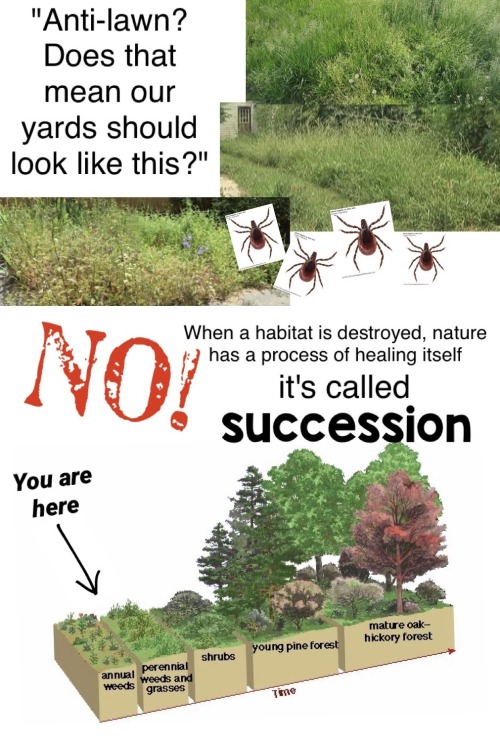
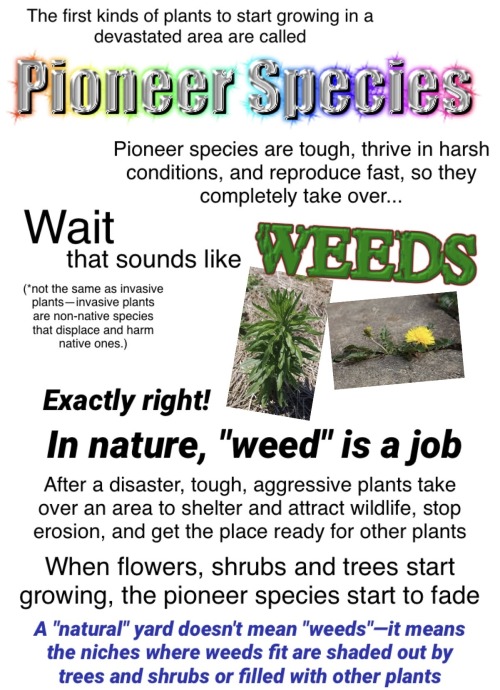
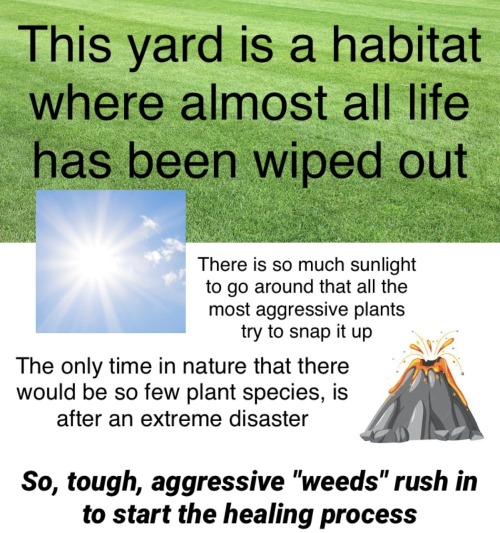
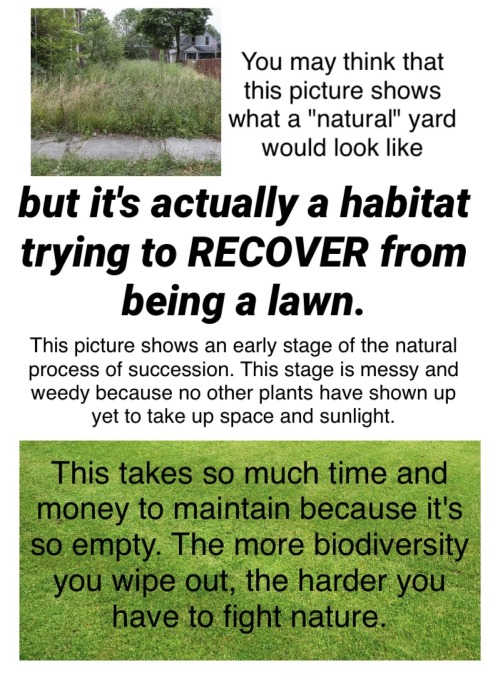
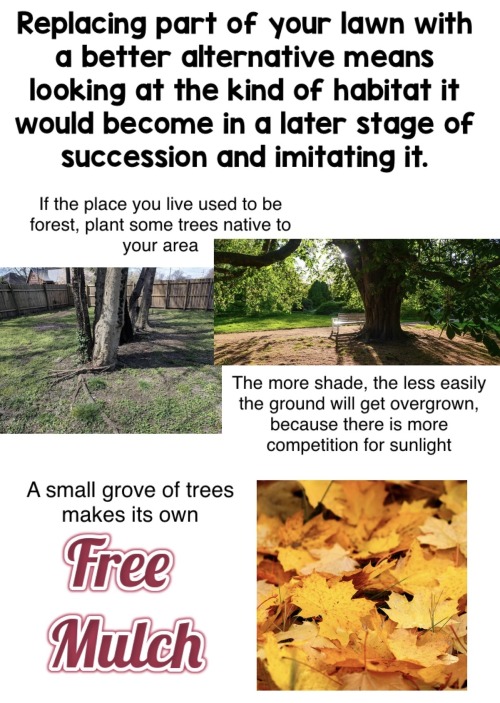
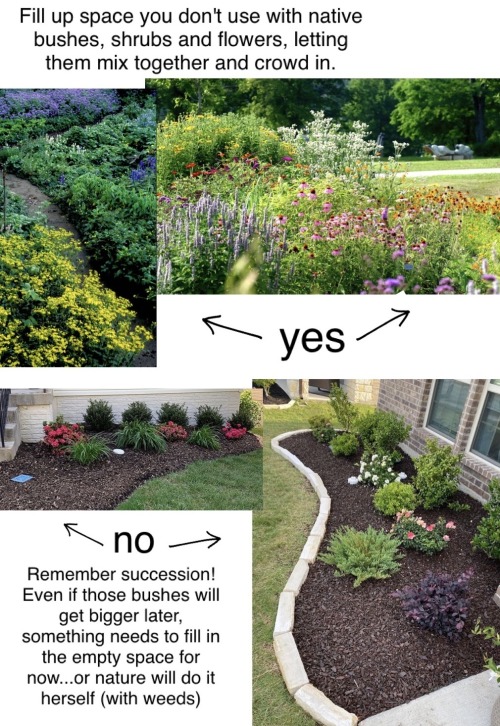
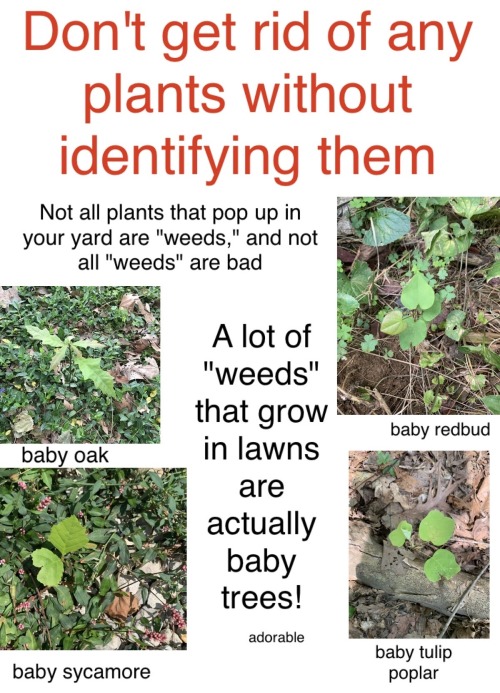
I...tried to make a meme and got carried away and made A Thing that is like partially unfinished because i spent like 3 hours on it and then got tired.
I think this is mostly scientifically accurate but truth be told, there seems to be relatively little research on succession in regards to lawns specifically (as opposed to like, pastures). I am not exaggerating how bad they are for biodiversity though—recent research has referred to them as "ecological deserts."
Feel free to repost, no need for credit
Your body is an ancestor. Your body is an altar to your ancestors. Every one of your cells holds an ancient and anarchic love story. Around 2.7 billion years ago free-living prokaryotes melted into one another to form the mitochondria and organelles of the cells that build our bodies today. All you need to do to honor your ancestors is to roll up like a pill bug, into the innate shape of safety: the fetal position. The curl of your body, then, is an altar not just to the womb that grew you, but to the retroviruses that, 200 million years ago taught mammals how to develop the protein syncytin that creates the synctrophoblast layer of the placenta. Breathe in, slowly, knowing that your breath loops you into the biome of your ecosystem. Every seven to ten years your cells will have turned over, rearticulated by your inhales and exhales, your appetites and proclivity for certain flavors. If you live in a valley, chances are the ancient glacial moraine, the fossils crushed underfoot, the spores from grandmotherly honey fungi, have all entered into and rebuilt the very molecular make up of your bones, your lungs, and even your eyes. Even your lungfuls of exhaust churn you into an ancestor altar for Mesozoic ferns pressurized into the fossil fuels. You are threaded through with fossils. Your microbiome is an ode to bacterial legacies you would not be able to trace with birth certificates and blood lineages. You are the ongoing-ness of the dead. The alembic where they are given breath again. Every decision, every idea, every poem you breathe and live is a resurrection of elements that date back to the birth of this universe itself. Today I realize that due to the miracle of metabolic recycling, it is even possible that my body, somehow, holds the cells of my great-great grandmother. Or your great-great grandmother. Or that I am built from carbon that once intimately orchestrated the flight of a hummingbird or a pterodactyl. Your body is an ecosystem of ancestors. An outcome born not of a single human thread, but a web of relations that ripples outwards into the intimate ocean of deep time.
Your Body is an Ancestor, Sophie Strand
“I very proudly entered the forestry school as an 18-year-old and telling them that the reason that I wanted to study botany was because I wanted to know why asters and goldenrod looked so beautiful together. These are these amazing displays of this bright, chrome yellow and deep purple of New England aster, and they look stunning together. And the two plants so often intermingle rather than living apart from one another, and I wanted to know why that was. I thought that surely in the order and the harmony of the universe, there would be an explanation for why they looked so beautiful together. And I was told that that was not science, that if I was interested in beauty, I should go to art school. Which was really demoralizing as a freshman, but I came to understand that question wasn’t going to be answered by science, that science, as a way of knowing, explicitly sets aside our emotions, our aesthetic reactions to things. We have to analyze them as if they were just pure material, and not matter and spirit together. And, yes, as it turns out, there’s a very good biophysical explanation for why those plants grow together, so it’s a matter of aesthetics and it’s a matter of ecology. Those complimentary colors of purple and gold together, being opposites on the color wheel, they’re so vivid, they actually attract far more pollinators than if those two grew apart from one another. So each of those plants benefits by combining its beauty with the beauty of the other. And that’s a question that science can address, certainly, as well as artists. And I just think that “Why is the world so beautiful?” is a question that we all ought to be embracing.”
— Robin Wall Kimmerer, “The Intelligence of Plants”, from the podcast On Being with Krista Tippett



Hey y’all here’s something I drew for my queer studies class last semester 🏳️⚧️
I wasn’t able to put too much time into it but I’m pretty proud of how it turned out, especially the mycelium rib cage 🩻🍄🟫
Happy pride! 💚
It's amazing how much of our knowledge of "animal behaviour" is based on very old studies that just went "we half-starved these animals and put them in a tiny box together and just assumed that whatever they did reflects their natural behaviours and social structures"







I...tried to make a meme and got carried away and made A Thing that is like partially unfinished because i spent like 3 hours on it and then got tired.
I think this is mostly scientifically accurate but truth be told, there seems to be relatively little research on succession in regards to lawns specifically (as opposed to like, pastures). I am not exaggerating how bad they are for biodiversity though—recent research has referred to them as "ecological deserts."
Feel free to repost, no need for credit
INKTOBER
Day 21: Rhinoceros. Nova Kachovka.

Day 22: Camp.
The solovki special camp was the largest soviet concentration camp. Nowadays, russians have created a lot of concentration camps, where they send Ukrainian POWs and civilians to torture or kill them.










russia commits ecocide in Ukraine
I would like to propose an experiment.
Now forgive me if such a thing already exists or is ongoing but I am typing this while at work and don't have time to research.
So take a big patch of land and put a tree farm on it. Mostly fill it up with a fast growing tree species (perhaps a fast growing species of pine) but also evenly space a second species of much larger but slower growing tree. Then periodically harvest and replant the faster trees while leaving the slower trees alone.
Also cut the farm in half. On one half do a seasonal burn of the lower brush and on the other half don't.
The goal of this experiment would be to see how the size of the larger trees impacts the growth of the smaller trees and other biotic and abiotic factors.
Will they help them grow faster?
Will they make them grow more slowly?
How will the bigger trees impact the soil?
How will the smaller trees impact the soil?
What kinds of fauna will this benefit?
What kinds of fauna will this harm?
Will this help or harm the ecosystem in and around the tree farm?
How does the fire impact the soil?
How does the fire impact the trees?
How does the fire impact the fauna?
How does the fire affect the nutrient cycle?
How do the big trees impact the nutrient cycle?
How do the small trees impact the nutrient cycle?
Ask someone who studied fungi to tell you what the hell they are doing.
Will this encourage or discourage biodiversity?
"Do you ever dream of land?" The whale asks the tuna.
"No." Says the tuna, "Do you?"
"I have never seen it." Says the whale, "but deep in my body, I remember it."
"Why do you care," says the tuna, "if you will never see it."
"There are bones in my body built to walk through the forests and the mountains." Says the whale.
"They will disappear." Says the tuna, "one day, your body will forget the forests and the mountains."
"Maybe I don't want to forget," Says the whale, "The forests were once my home."
"I have seen the forests." Whispers the salmon, almost to itself.
"Tell me what you have seen," says the whale.
"The forests spawned me." Says the salmon. "They sent me to the ocean to grow. When I am fat with the bounty of the ocean, I will bring it home."
"Why would the forests seek the bounty of the oceans?" Asks the whale. "They have bounty of their own."
"You forget," says the salmon, "That the oceans were once their home."
Science Coming Soon to a Space Station Near You
Dozens of science experiments will soon make their red carpet debuts on the International Space Station. They will arrive courtesy of a Dragon cargo spacecraft launched from Cape Canaveral Air Force Station in Florida. The starring players include investigations into 3D printing organ tissue, breaking up rocks and building bones.
Meet some of the experiments blasting off that could lead to the development of new technologies as well as improve life on Earth.
Grab yourself an (organ) tissue
Scientists and medical professionals have long dreamed of the day 3D printers can be used to create useable human organs. But pesky gravity seems to always get in the way.

Enter microgravity. The new BioFabrication Facility (BFF) will provide a platform to attempt the creation of this organ tissue on the space station, a potential first step towards creating entire human organs in space.
Put down your pickaxe and pick up some microbes
Extracting minerals from rocks doesn’t always require brute force. Microbes can be deployed for the same purpose in a process called bio-mining. While common on Earth, the method still needs to be explored in space to see if it can eventually help explorers on the Moon and Mars. The BioRock investigation will examine the interactions between microbes and rocks and see if microgravity could limit the use of bio-mining by restricting bacterial growth.

Keep rolling along
Goodyear Tire will investigate if microgravity can help improve the silica design process, silica rubber formation and tire manufacturing. This investigation could lead to improvements like better tire performance and increased fuel efficiency, putting a bit of cash back in your pocket.

When space gets on our nerves
Meet microglia: a type of immune defense cell found in the central nervous system. Better understanding nerve cells and their behavior in microgravity is crucial to protecting astronaut health.
The Space Tango-Induced Pluripotent Stem Cells experiment will convert induced pluripotent stem cells (iPSCs) derived from patients with Parkinson’s and Multiple Sclerosis into different types of brain cells. Researchers will examine two things:
How microglial cells grow and move
Changes in gene expression in microgravity

Studying this process in microgravity could reveal mechanisms not previously understood and could lead to improved prevention and treatments for the diseases.
Space moss!
Moss, the tiny plants you see covering rocks and trees in the woods, change how they behave once the gravity in their environment changes. Space Moss compares the mosses grown aboard the space station with your typical run-of-the-mill Earth-bound moss.

This investigation will let researchers see how moss behavior in space could allow it to serve as a source of food and oxygen on future Moon or Mars bases.
A smooth connection
Docking with the space station requires physical points for connections, and International Docking Adapters (IDAs) are providing a more sophisticated way of doing so.

IDA 3 will be attached to the Harmony mode, home to two existing IDAs. This adapter can accommodate commercial crew vehicle dockings, such as the first spacecraft to launch from U.S. soil since the space shuttle.
Building a better bone
The Cell Science-02 investigation will improve our understanding of tissue regeneration and allow us to develop better countermeasures to fight loss of bone density by astronauts.

By examining the effects of microgravity on healing agents, this investigation may be able to assist people on Earth being treated for serious wounds or osteoporosis.
Want to learn about more investigations heading to the space station (or even ones currently under way)? Make sure to follow @ISS_Research on Twitter and Space Station Research and Technology News on Facebook.
If you want to see the International Space Station with your own eyes, check out Spot the Station to see it pass over your town.
Make sure to follow us on Tumblr for your regular dose of space: http://nasa.tumblr.com.

